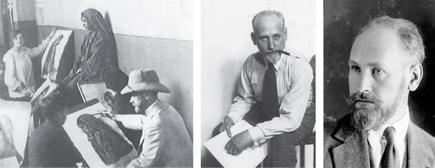
| HOME |
| ARTISTS |
| CATALOGUES |
| PANN'S BIBLE |
|
|
| PAINTINGS | |
| DRAWINGS | |
| PARISIAN PERIOD | |
| BIBLICAL LITHOGRAPHS | |
| OLD BIBLICAL PRINTS | |
| PEOPLE OF JERUSALEM | |
| POGROMS LITHOGRAPHS | |
| OLD BOOKS | |
| OTHERS | |
| SOLD | |
| ABOUT THE ARTIST |
Abel Pann was born in Latvia in 1883. His father was a rabbi and the head of a yeshiva (Jewish religious school). At an early age he showed interest in drawing and studied in an art school in Odessa. In 1903, he moved to Paris and continued his studies in an art academy. One of his teachers was the French painter Adolphe William Bourguereau. His works aroused much interest, winning him prizes and medals. His works were exhibited together with those of Renoir and Matisse. He contributed to humoristic journals and was a member of the "Salon des Humoristes" in Paris. In the course of time he became well-known in the French capital.
In 1913, he went to Palestine and taught at the Bezalel Academy of Art for a year. A few weeks before World War I broke out, he traveled to Paris, intending to return to Palestine shortly afterwards. Because of the war he was prevented from doing so. When it became known that pogroms had taken place in Russia, he drew paintings on that theme, his purpose being to print reproductions of them. However, the Russian Minister in Paris was informed of this project and succeeded in convincing the French government of the necessity to forbid the printing. During the war, he painted war subjects, depicting French patriotism and the French war effort. Even before that date he began to paint biblical themes but thereafter dedicated his work mainly to the Bible. Now he used pastel colors, whereas formerly he had painted in oil. He viewed the Bible realistically and the people and landscapes of his paintings are of the Orient, as he saw them in Palestine. This is one of the innovations of his work.
2000 - The Jewish Museum Vienna presented the exhibition of "Abel Pann - The painter of The Bible." An accompanying catalogue was published with text by Shlomit Steinberg and Felix Salten. 2003 - The Israel Museum presented a major exhibition, "The Art of Abel Pann from Montparnasse to the Bible." A substantial catalogue of the same title was published with text by Yigal Zalmona. Yael Gahnassia and Mayanot Gallery were pleased to participate by loaning works. 2005 - Israel Museum pubished a catalogue edited by Yigal Zalmona for "Les amis du village suisse d'enfants Kiriath Yearim."
|
||||
| HOME ABOUT | |

 In 1917, he traveled to the United States where the Union of Museums organized exhibitions of his works in several cities. In 1920, he returned to Palestine to settle permanently and until 1924 taught again at Bezalel. In 1921, he established the first lithographic installation in Palestine, where lithographs of his works were made.
In 1917, he traveled to the United States where the Union of Museums organized exhibitions of his works in several cities. In 1920, he returned to Palestine to settle permanently and until 1924 taught again at Bezalel. In 1921, he established the first lithographic installation in Palestine, where lithographs of his works were made. One of his critics pointed out that "this time the Bible is seen by the eyes of Shem and not of Japhet and there is a feeling that this is the correct interpretation." In the twenties and thirties he held many exhibitions in Western and Central Europe. His works, including reproductions of them, are widely known all over the world.
One of his critics pointed out that "this time the Bible is seen by the eyes of Shem and not of Japhet and there is a feeling that this is the correct interpretation." In the twenties and thirties he held many exhibitions in Western and Central Europe. His works, including reproductions of them, are widely known all over the world. In the course of World War II, he drew paintings of the Holocaust, but at the same time continued to paint themes of Eretz Israel.
In the course of World War II, he drew paintings of the Holocaust, but at the same time continued to paint themes of Eretz Israel.